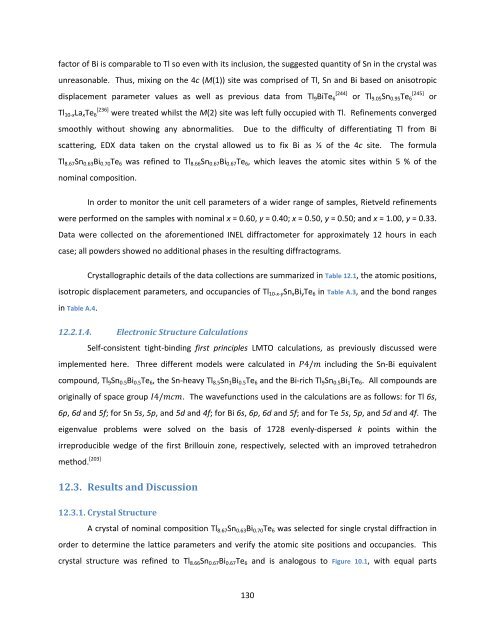Exploration and Optimization of Tellurium‐Based Thermoelectrics
Exploration and Optimization of Tellurium‐Based Thermoelectrics
Exploration and Optimization of Tellurium‐Based Thermoelectrics
Create successful ePaper yourself
Turn your PDF publications into a flip-book with our unique Google optimized e-Paper software.
factor <strong>of</strong> Bi is comparable to Tl so even with its inclusion, the suggested quantity <strong>of</strong> Sn in the crystal was<br />
unreasonable. Thus, mixing on the 4c (M(1)) site was comprised <strong>of</strong> Tl, Sn <strong>and</strong> Bi based on anisotropic<br />
displacement parameter values as well as previous data from Tl9BiTe6 [244] or Tl9.05Sn0.95Te6 [245] or<br />
Tl10‐xLaxTe6 [236] were treated whilst the M(2) site was left fully occupied with Tl. Refinements converged<br />
smoothly without showing any abnormalities. Due to the difficulty <strong>of</strong> differentiating Tl from Bi<br />
scattering, EDX data taken on the crystal allowed us to fix Bi as ⅓ <strong>of</strong> the 4c site. The formula<br />
Tl8.67Sn0.63Bi0.70Te6 was refined to Tl8.66Sn0.67Bi0.67Te6, which leaves the atomic sites within 5 % <strong>of</strong> the<br />
nominal composition.<br />
In order to monitor the unit cell parameters <strong>of</strong> a wider range <strong>of</strong> samples, Rietveld refinements<br />
were performed on the samples with nominal x = 0.60, y = 0.40; x = 0.50, y = 0.50; <strong>and</strong> x = 1.00, y = 0.33.<br />
Data were collected on the aforementioned INEL diffractometer for approximately 12 hours in each<br />
case; all powders showed no additional phases in the resulting diffractograms.<br />
Crystallographic details <strong>of</strong> the data collections are summarized in Table 12.1, the atomic positions,<br />
isotropic displacement parameters, <strong>and</strong> occupancies <strong>of</strong> Tl10‐x‐ySnxBiyTe6 in Table A.3, <strong>and</strong> the bond ranges<br />
in Table A.4.<br />
12.2.1.4. Electronic Structure Calculations<br />
Self‐consistent tight‐binding first principles LMTO calculations, as previously discussed were<br />
implemented here. Three different models were calculated in 4/ including the Sn‐Bi equivalent<br />
compound, Tl9Sn0.5Bi0.5Te6, the Sn‐heavy Tl8.5Sn1Bi0.5Te6 <strong>and</strong> the Bi‐rich Tl9Sn0.5Bi1Te6. All compounds are<br />
originally <strong>of</strong> space group 4/. The wavefunctions used in the calculations are as follows: for Tl 6s,<br />
6p, 6d <strong>and</strong> 5f; for Sn 5s, 5p, <strong>and</strong> 5d <strong>and</strong> 4f; for Bi 6s, 6p, 6d <strong>and</strong> 5f; <strong>and</strong> for Te 5s, 5p, <strong>and</strong> 5d <strong>and</strong> 4f. The<br />
eigenvalue problems were solved on the basis <strong>of</strong> 1728 evenly‐dispersed k points within the<br />
irreproducible wedge <strong>of</strong> the first Brillouin zone, respectively, selected with an improved tetrahedron<br />
method. [203]<br />
12.3. Results <strong>and</strong> Discussion<br />
12.3.1. Crystal Structure<br />
A crystal <strong>of</strong> nominal composition Tl8.67Sn0.63Bi0.70Te6 was selected for single crystal diffraction in<br />
order to determine the lattice parameters <strong>and</strong> verify the atomic site positions <strong>and</strong> occupancies. This<br />
crystal structure was refined to Tl8.66Sn0.67Bi0.67Te6 <strong>and</strong> is analogous to Figure 10.1, with equal parts<br />
130
















